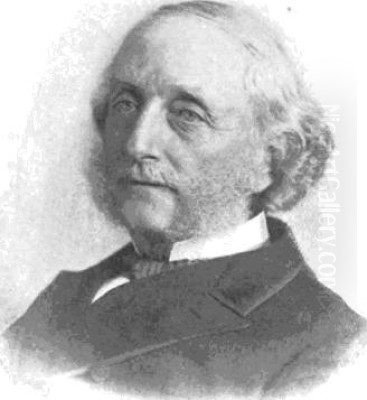
William Bradford stands as a significant figure in nineteenth-century American art, a painter whose canvases captured the dramatic beauty of the sea and the awe-inspiring, icy landscapes of the Far North. Born in Fairhaven, Massachusetts, in 1823, into a devout Quaker family, Bradford carved a unique path, transitioning from commerce to art and ultimately becoming renowned as America's premier painter of the Arctic regions. His work blends the meticulous observation of a realist with the dramatic sensibility of a Romantic, leaving behind a legacy of powerful images that explore the interplay of light, water, ice, and human endeavor in extreme environments.
Early Life and Artistic Awakening in New Bedford
Bradford's upbringing in Fairhaven, adjacent to the bustling whaling port of New Bedford, profoundly shaped his artistic inclinations. Though initially guided towards the family's retail dry goods business, the maritime world surrounding him proved an irresistible draw. The harbor teemed with activity – whaling ships returning from long voyages, coastal schooners navigating the waters, the constant play of light on the waves. This environment provided endless subjects for a young man developing an interest in drawing and painting.
Despite his family's Quaker background, which often encouraged practicality over artistic pursuits, Bradford's passion for art grew. He was largely self-taught in his early years, honing his skills by sketching the ships and harbor scenes that defined his hometown. The precision and detail evident even in his early work suggest an innate observational talent, perhaps subtly influenced by the Quaker emphasis on truthfulness and directness. By his late twenties or early thirties, Bradford made the decisive shift, leaving the family business to dedicate himself fully to a career as a professional artist.
Formative Training and Influences
While primarily self-directed, Bradford did receive crucial, albeit brief, formal training from Albert Van Beest, a Dutch marine painter who arrived in New Bedford around 1854. Van Beest, trained in the dramatic traditions of Dutch marine art, worked closely with Bradford for several years, even sharing a studio. They collaborated on several canvases, with Van Beest often adding the shipping elements to Bradford's seascapes.
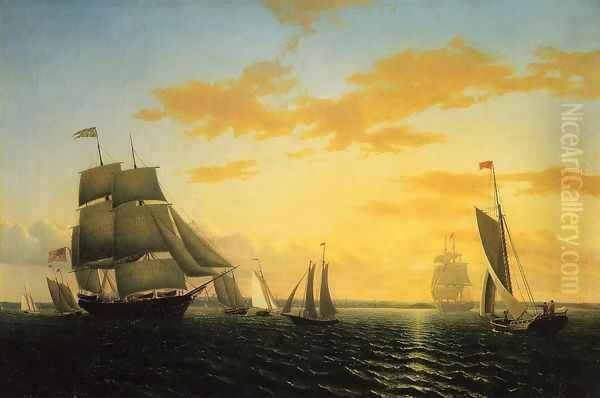
This collaboration exposed Bradford to a more dynamic, European style, characterized by energetic brushwork and heightened atmospheric effects. For a time, Bradford experimented with Van Beest's more theatrical approach. However, he ultimately gravitated back towards his own developing style, which balanced dramatic effect with a greater degree of realism and meticulous detail, particularly in the rendering of ships and rigging. Van Beest's influence remained, perhaps most notably in Bradford's sophisticated understanding of wave dynamics and atmospheric perspective, but Bradford integrated these lessons into his distinctly American sensibility. Beyond Van Beest, Bradford likely absorbed influences from earlier marine painters active in New England, such as the British-born Robert Salmon, known for his crisp, detailed harbor views.
Mastering the Marine View
Before his celebrated Arctic voyages, Bradford established himself as a highly skilled marine painter. His primary subjects were the vessels that populated New Bedford harbor and the surrounding waters. He became known for his accurate "ship portraits," commissioned by proud captains and owners who desired faithful representations of their vessels. These works required not only artistic skill but also a deep understanding of naval architecture and rigging, which Bradford clearly possessed.
His harbor scenes from this period often capture the specific quality of light along the New England coast. Works like New Bedford Harbor at Sunset (c. 1856-58) exemplify his growing mastery. This painting, notably included in an exhibition curated by the prominent landscape painter Albert Bierstadt in 1858, showcases Bradford's sensitivity to light and atmosphere. The calm water reflects the warm hues of the setting sun, and the carefully rendered ships rest peacefully in the tranquil harbor. Such works connect Bradford to the developing Luminist movement in American painting, characterized by its focus on light, serene atmosphere, and often smooth, detailed finish, seen also in the work of artists like Fitz Henry Lane and Martin Johnson Heade.
The Lure of the North: Arctic Expeditions
Bradford's artistic vision expanded dramatically in the late 1850s and 1860s as he turned his attention northward. The Arctic held a powerful grip on the nineteenth-century imagination, fueled by tales of exploration, scientific curiosity, and the dramatic search for Sir John Franklin's lost expedition (which had departed in 1845). For Bradford, the region offered unparalleled subjects: towering icebergs, frozen seas, the unique effects of Arctic light, and the human drama of navigation in perilous waters.
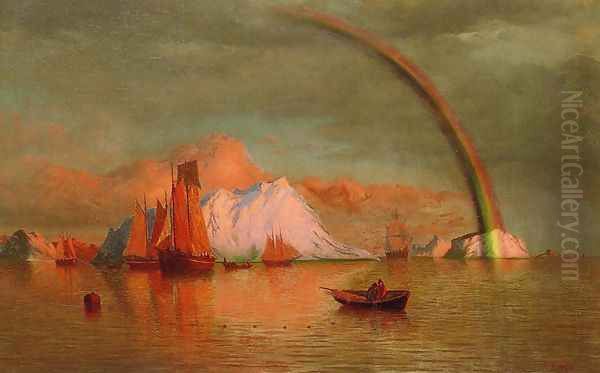
Beginning in the early 1860s, Bradford financed and undertook several expeditions, initially sailing along the coasts of Nova Scotia and Labrador. These trips allowed him to sketch icebergs firsthand as they drifted south. His ambition grew, culminating in a major expedition in 1869 aboard the steamship Panther. Accompanied by patrons, fellow artists, and importantly, two photographers, John L. Dunmore and George Critcherson, Bradford sailed up the western coast of Greenland, reaching as far north as Melville Bay. This voyage provided the raw material – sketches, notes, and hundreds of photographs – for many of his most famous Arctic paintings. These expeditions were arduous and expensive, often funded by wealthy patrons like LeGrand Lockwood, demonstrating Bradford's commitment to experiencing his subjects directly.
Capturing the Arctic Sublime: Style and Technique
Bradford's Arctic paintings are masterpieces of nineteenth-century Romantic landscape painting, infused with a sense of the sublime – the feeling of awe, wonder, and even terror evoked by the overwhelming power and scale of nature. He sought to convey the unique character of the Arctic environment: the colossal forms of icebergs, the vast emptiness of the frozen seas, and the ethereal quality of the light, whether the perpetual twilight of the midnight sun or the dramatic glow of the aurora borealis.
His style combined meticulous realism in the depiction of ice formations and ships with a Romantic emphasis on atmosphere and dramatic effect. He paid close attention to the way light interacted with ice, capturing the subtle blues, greens, and violets within the frozen masses and the dazzling reflections on the water. Unlike some Hudson River School painters who occasionally depicted icebergs, such as Frederic Edwin Church, Bradford made the Arctic his central, defining subject.
Bradford often employed compositional strategies to enhance the impact of his scenes. He frequently used dark foreground elements or framing devices to draw the viewer's eye towards a brightly lit central subject, such as a ship navigating through ice or a particularly spectacular iceberg. His palette could range from cool, crisp blues and whites to surprisingly warm tones, especially in sunset or sunrise scenes over the ice. The level of detail remained high, grounding the potentially fantastical scenes in observed reality.
Photography as an Artistic Partner
William Bradford was among the first American artists to significantly integrate photography into his working process, particularly for his Arctic subjects. The 1869 Panther expedition yielded a substantial body of photographic work, capturing icebergs, coastal formations, Inuit communities, and the ship itself amidst the ice. These photographs served multiple purposes. They were valuable documents of the expedition and the Arctic environment, providing a level of detail and accuracy difficult to capture solely through sketching in challenging conditions.
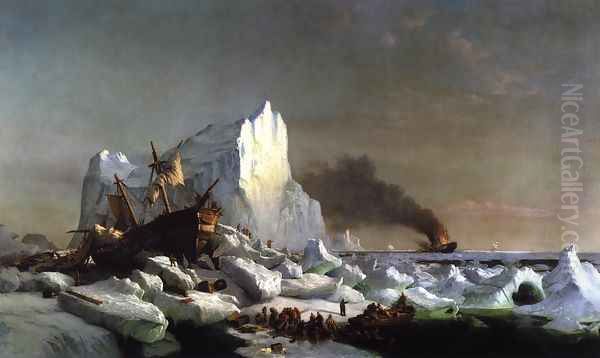
More importantly for Bradford's art, the photographs served as crucial reference material back in his studio. They allowed him to accurately recall the complex forms of icebergs and the details of the ship and its rigging long after the voyage ended. This use of photography enabled the high degree of realism present in his finished oil paintings. However, Bradford did not simply copy photographs. He used them as aids, combining information from multiple photos, sketches, and his own memory to compose his large-scale studio canvases, always interpreting the scene through his artistic vision to heighten the dramatic and emotional impact.
This pioneering use of photography in conjunction with painting was innovative for its time. It acknowledged the camera's power for documentation while affirming the artist's role in interpretation and composition. The photographs themselves, particularly those published in his book The Arctic Regions, stand as significant early examples of Arctic photography.
The Arctic Regions and Major Works
The culmination of the 1869 expedition was not only a series of major paintings but also the publication of the lavish volume The Arctic Regions in London in 1873. This book featured text describing the voyage alongside 138 mounted original photographs by Dunmore and Critcherson. It was a landmark publication, bringing the stark beauty and alien landscapes of the Arctic directly to a wider audience and cementing Bradford's reputation as an explorer-artist.
Bradford's major paintings often depict ships, dwarfed by the immense scale of the ice, navigating treacherous passages. Steamer 'Panther' in Melville Bay, under the Light of the Midnight Sun (also known as The Panther off the Coast of Greenland under the Midnight Sun) is perhaps his most famous work, commissioned by Queen Victoria herself. It captures the vessel nestled amongst towering icebergs, bathed in the eerie, perpetual light of the Arctic summer night. The painting balances the vulnerability of the man-made ship with the majestic, indifferent power of nature.
Other significant works explore different facets of the Arctic experience. Arctic Sunset showcases his ability to render dramatic atmospheric effects, with warm light suffusing the icy landscape. Paintings like Vessels among Icebergs after a Storm emphasize the dangers faced by mariners, while others focus purely on the sculptural beauty and varied colors of the icebergs themselves. His Luminist Abandoned Whaling Ship Off the Coast of Labrador combines his interest in maritime subjects with the starkness of the northern environment, evoking a sense of melancholy and isolation. Earlier works like Whalehips Fireh Perry (1852) represent his foundational work in ship portraiture.
Contemporaries and Collaborations
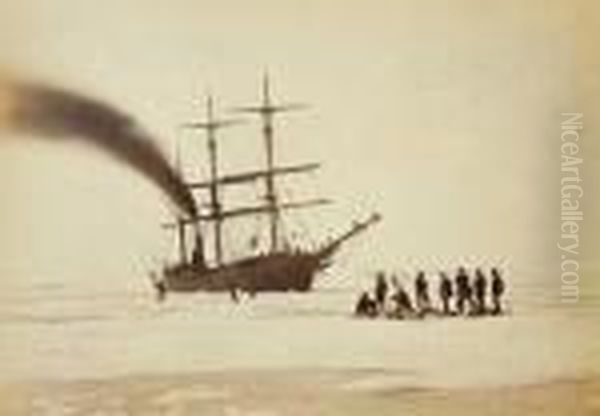
Bradford's career intersected with many prominent figures in American art. His early collaboration with Albert Van Beest was formative. As a painter of grand natural spectacles, his work resonates with that of the Hudson River School painters, particularly Albert Bierstadt, known for his monumental canvases of the American West, and Frederic Edwin Church, who painted South American landscapes and also ventured into depicting icebergs after a trip to Labrador. Bradford exhibited alongside these artists and shared their interest in capturing the unique landscapes of the Americas.
His connection to Luminism links him to painters like Fitz Henry Lane and Martin Johnson Heade, who shared his sensitivity to light and atmosphere, though Bradford applied these concerns to more dramatic and remote subjects. He also collaborated on a different kind of project, working with Caleb P. Purrell on a large moving panorama depicting a whaling voyage, a popular form of entertainment in the mid-nineteenth century. While distinct from his easel paintings, this project further demonstrates his deep engagement with maritime themes. His work can also be seen in the broader context of international marine painting, drawing on traditions established by Dutch Golden Age masters and finding parallels in the atmospheric sea- and icescapes of British Romantic painters like J.M.W. Turner. Other American marine specialists like James E. Buttersworth focused more on yachting scenes, providing a contrast to Bradford's more rugged subjects. Figures like Sanford Robinson Gifford and Jasper Francis Cropsey, also associated with the Hudson River School, explored light effects in different landscape contexts.
Recognition at Home and Abroad
William Bradford achieved considerable recognition during his lifetime, both in the United States and in Great Britain. His exhibitions in Boston and New York were well-received, establishing his reputation as a leading marine painter. His Arctic scenes, however, brought him international fame. He spent several years in London during the 1870s, where his work found an appreciative audience fascinated by images of the remote and dangerous North.
The highlight of his time in London was undoubtedly the patronage of Queen Victoria. Impressed by his work, she commissioned the large painting The Panther off the Coast of Greenland under the Midnight Sun for Windsor Castle. This royal commission significantly boosted his prestige. He exhibited works at the Royal Academy of Arts in London, further solidifying his standing. Back in the United States, his paintings were shown at major venues like the National Academy of Design in New York and the Boston Athenaeum. Wealthy American collectors, including railroad magnates in California, also acquired his major canvases.
Later Life and Continued Work
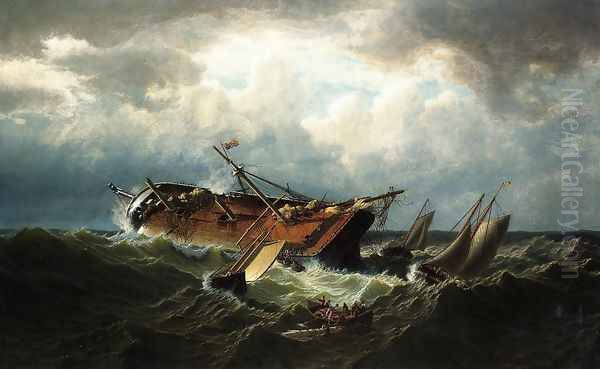
After his productive years in London, Bradford returned to the United States, maintaining a studio in New York City for much of his later career. He continued to paint, drawing upon the wealth of sketches and photographs from his northern voyages. He also became a popular lecturer, sharing his experiences and images of the Arctic with audiences at institutions like the American Geographical Society.
His later works continued to explore Arctic themes, often revisiting successful compositions or focusing on specific light effects. While the peak of Arctic exploration fever may have passed, Bradford remained associated with the subject he had made his own. He continued exhibiting his work until the final years of his life, passing away in New York City in 1892.
Market Performance and Collections
Bradford's work found buyers throughout his career. Early ship portraits and harbor scenes commanded modest but respectable prices for the time, such as the $25 received for Whalehips Fireh Perry in 1852 or $97.50 for a New Bedford scene at a later auction. His large Arctic canvases, particularly after his London success, commanded much higher prices, reflecting their scale, ambition, and the artist's growing reputation.
In the modern era, William Bradford's paintings are highly sought after by collectors and institutions. His works appear regularly at major auction houses like Sotheby's, Christie's, Phillips, and Skinner. Prices vary significantly depending on size, subject matter, condition, and provenance. While smaller works or studies might sell for tens of thousands of dollars, his major Arctic canvases can command prices in the millions. For instance, a Boston Harbor scene sold for over $3 million at Skinner in 2013, and other works have achieved seven-figure results at various auction houses, with estimates sometimes reaching as high as $5 million (e.g., Boreas at Christie's). His book, The Arctic Regions, is also a valuable collector's item, with copies selling for significant sums (e.g., £79,250 at Sotheby's).
Bradford's paintings are held in the permanent collections of numerous major museums, including the Metropolitan Museum of Art in New York, the Museum of Fine Arts, Boston, the de Young Museum in San Francisco, and crucially, the New Bedford Whaling Museum, which holds a significant collection reflecting his deep ties to the city and its maritime history. Other institutions like the Cape Ann Museum also hold and exhibit his work.
Exhibitions and Enduring Legacy
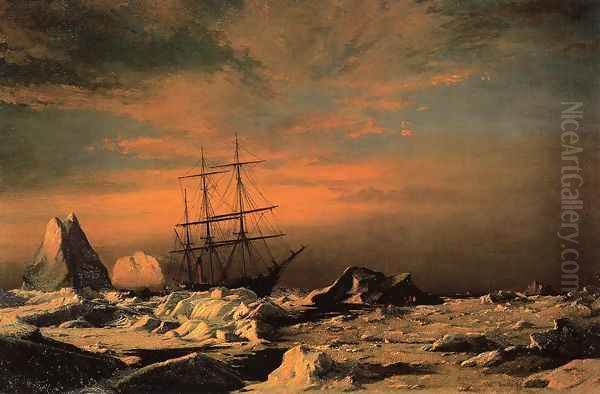
William Bradford's work has been the subject of numerous exhibitions, both during his lifetime and posthumously. Retrospectives like the one organized by the Cape Ann Museum, titled William Bradford: Sailing Ships and Arctic Seas, have brought together significant numbers of his paintings, providing comprehensive overviews of his career and shedding new light on his expeditions and artistic development through accompanying scholarship. Planned exhibitions focusing on his book The Arctic Regions and its intersection with art, science, and environmental understanding continue to explore the relevance of his work.
Bradford's legacy is multifaceted. He was a pioneer in the artistic exploration of the Arctic, bringing its unique and challenging landscapes into the mainstream of American art. His skillful blending of Romantic sensibility with detailed realism created powerful and enduring images of the natural world. His innovative use of photography as an integral part of his artistic process foreshadowed later developments in the relationship between the two media. As a key figure in American marine painting and an artist connected to the broader currents of the Hudson River School and Luminism, William Bradford holds a secure place in the history of American art. His paintings continue to captivate viewers with their depiction of adventure, the sublime beauty of extreme environments, and the dramatic interplay of light, ice, and water.
Conclusion: An Explorer's Vision
William Bradford was more than just a painter; he was an explorer whose art was born from direct experience and a profound engagement with his subjects. From the familiar harbors of New England to the remote, icy wilderness of the Arctic, he sought to capture the essence of the maritime world and the awe-inspiring power of nature. His dedication to authenticity, whether through meticulous rendering or the use of photography, combined with his Romantic vision, resulted in a body of work that is both historically significant and visually compelling. Bradford remains celebrated for bringing the stark, dramatic beauty of the Arctic to the forefront of American landscape painting, leaving behind images that continue to resonate with themes of exploration, environmental wonder, and the human spirit confronting the sublime.